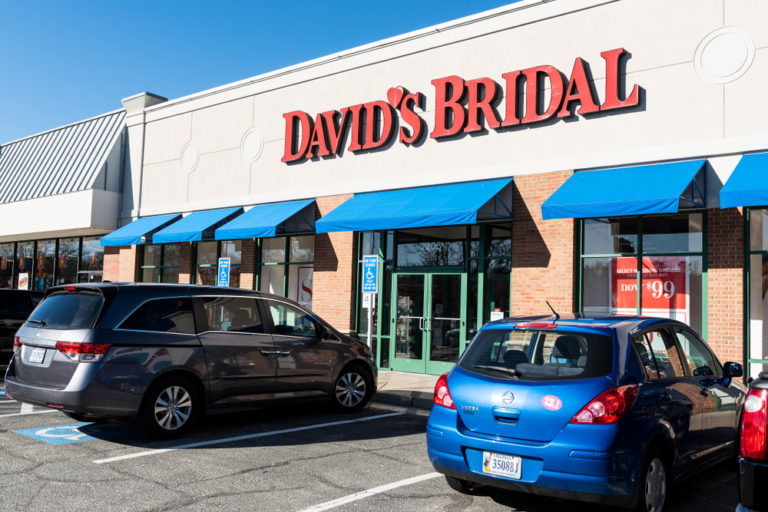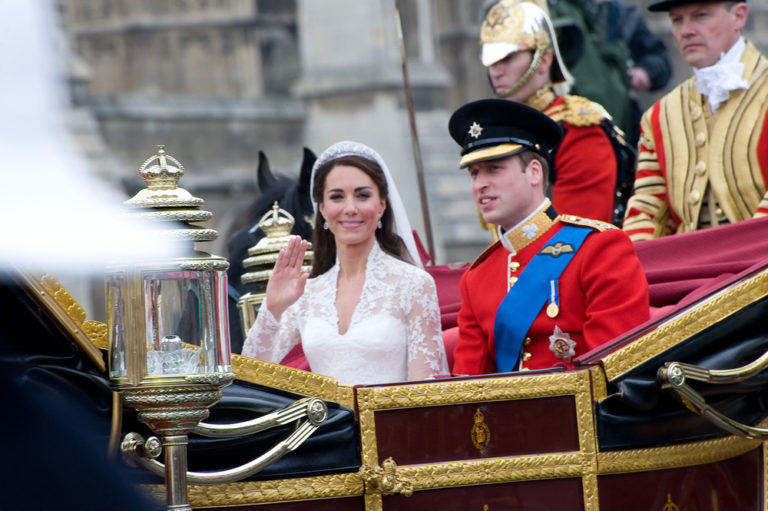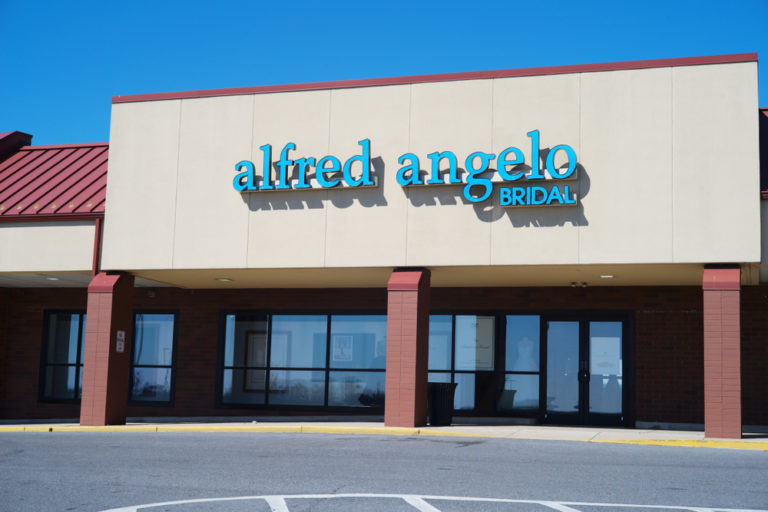Everything was perfect in Harry and Meghan’s wedding – which cost 45 million dollars according to Business Insider – from the ceremony in the Windsor Palace’s chapel and the traditional carriage procession, to Elton John’s reception performance.
However, the public was shocked by Meghan’s 135,000 dollars bridal dress, which – in all its elegance – was perceived as rather underwhelming. Knowingly or not, the author of the dress – British designer and the artistic director of the French fashion house Givenchy, Clare Waight Keller – followed the new trend that has gone unnoticed by a lot of bridal gown stores – both small shops and huge chains. And now that oversight has brought serious financial hardship or bankruptcy onto them.
The tsunami of store closures is gaining momentum
 When David’s Bridal, USA’s largest wedding dress retail chain, announced in October 2018 that it was not going to make the 270 million dollar interest payment, the media went into a frenzy, speculating bankruptcy or potential debt restructuring. Few believed that the company was in good health and that this was a “strategic decision.”
When David’s Bridal, USA’s largest wedding dress retail chain, announced in October 2018 that it was not going to make the 270 million dollar interest payment, the media went into a frenzy, speculating bankruptcy or potential debt restructuring. Few believed that the company was in good health and that this was a “strategic decision.”But we are talking about America’s biggest wedding dress retail chain that has been in business successfully for 60 years. A company that, impressively enough, was responsible for the sales of one third (!) of wedding dress sales in the US from their 330 stores and online shop.
So why are the rating agencies lowering David’s Bridal’s rating? One of the reasons is their failed 2016 “digital revolution” -- an initiative which was supposed to usher the chain into the 21
st
century. Unfortunately, the design of their web store fell flat and the new design actually made it
harder
for users to search for their products. This is a huge reason why the company’s earnings have dropped about 30% compared to 2012.
The second reason is even more significant than the first. This is not just David’s Bridal’s problem; the entire field is in a crisis. The second biggest bridal dress retail chain, Alfred Angelo Bridal, closed unexpectedly in the summer of 2017 without any prior notice. The collapse of the 60-store chain caused panic among the thousands of women who already paid for their dresses and were expecting to receive them in time for their wedding. In a matter of hours, the bankruptcy registrar received over 7,000 e-mails asking, pleading, and demanding for a dress. Shortly after, local newspapers in the United States published one sad article after another about the continued closure of small bridal boutiques. Some are burdened with debt; some just quietly pack up their business.
Large chain stores, with the best brains on their payroll, were not immune to the downfall of the bridal gown business. J.Crew closed their 12-year-old wedding apparel business in the fall of 2016. Back then their target group was, in their own words, “women who are savvy and extremely educated about what there is in the market, whether designers, quality or details.” 12 years later, they switched gears to start selling “what women like to wear to someone else’s wedding, versus what they would wear to their own” instead.
Even the clothing retail giant GAP, who started their bridal business in 2011, and purchased Weddington Way in 2016, had to admit this April: the bridal stores in their Banana Republic malls, as well as their web store, are closing.
What is happening in this 2.5 billion dollar industry? It can’t be that suddenly all of these business managers became incapable of selling bridal gowns.
More show, more individuality
The answer is a change in the market. These changes have always been there, what many failed to see was how they accumulated over the years.The first answer comes from the much-quoted
The Knot 2017 Real Weddings Study
that analyzed 13,000 married couples. Weddings still cost a fortune – 33,000 dollars on an average in America. The average wedding dress costs 1,500 dollars.
These days, individuality rules. Old customs are going out of fashion – such as the garter toss. Weddings are being held in decked out barns, parks, and even libraries or boxing gyms! About one fifth bring an exotic cultural into their wedding, like a Chinese tea ceremony or Moroccan belly dancers. So, what does this mean? In short, weddings are no longer exclusively black tie events. A dress gets picked from a “regular” store. The money saved on the dress is spent on entertainment or anything else to create a unique experience that is completely personalized to the wedded coupler.
250 dollars for Kate Middleton’s wedding dress? Why not!
 Women determine the face of the wedding. However, as more and more women focus on professional careers, the average age of marriage is rising. According to Forbes Magazine, it will be 27.4 for women by 2017.
Women determine the face of the wedding. However, as more and more women focus on professional careers, the average age of marriage is rising. According to Forbes Magazine, it will be 27.4 for women by 2017.The number of people who are planning to not get married also increasing – they make up almost 20% among Americans 25 and older.
Meanwhile, younger couples, who don’t deem a classical wedding important anymore, might buy a cheaper bridal gown from Anthropologie or ASOS.
The Swedish clothing brand H&M, also offering wedding collections now, came up with a completely different standard this spring. Their cheapest gown costs 149.99 dollars; and the one inspired by Kate Middleton’s wedding dress is only a hundred dollars more than that.
Just a couple of hundred dollars to feel like a princess!
New business models are barging in
 The United States’ bridal dress market is very fragmented and localized. After Alfred Angelo Bridal shutdown last year, David’s Bridal is the only big bridal dress retail chain left. There’s a large gap in between them and the hundreds of local shops, each only owning 1-2% of the market share. This means that those fragmented companies cannot use the basis of centralized manufacturing.
The United States’ bridal dress market is very fragmented and localized. After Alfred Angelo Bridal shutdown last year, David’s Bridal is the only big bridal dress retail chain left. There’s a large gap in between them and the hundreds of local shops, each only owning 1-2% of the market share. This means that those fragmented companies cannot use the basis of centralized manufacturing.For a customer, this means a limited selection and an order wait time that could very well be as long as a year. On top of those concerns also lie the gnawing fear that the company might go belly-up within that year.
According to the online bridal dress service provider Anomalie, around 80% of women who came to the classical bridal gown store, after having started their dress hunt, were deeply dissatisfied with the service at other businesses. Their average rating was 1.5 out of 5.
Meanwhile, this has allowed companies that use completely new business models to enter the market – companies like Anomalie, for example. Anomalie was founded by the Harvard-graduate Leslie Voorhees, who happened to visit the Suzhou region in China, where the majority of the world’s bridal gowns come from. Using her Chinese bridal dress experience, she created a company that combines online ordering (including choosing the style and giving your measurements), phone consultation with the designer, centralized operations (purchasing materials, production, shipping), and local after service, if needed.
Anomalie offers a limited range of styles, materials, colors, and details, which allows fast manufacturing. However, by combining the elements they already have, they are able to sustain a range of styles sufficient enough provide customers with unique dresses. Consultation with the designer (without mediators – Anomalie works directly with a top designer) and reviewing the sketch with customers online helps avoid lapses of judgment or any other pitfalls. This processes also makes Anomalie's unique dresses accessible to brides who cannot find one from a traditional store.
The result: Anomalie’s bridal dresses are capable of competing with the 10,000 dollar designer dresses that otherwise take a whole year to be completed. In comparison, Anomalie’s dresses can be bought for 1,000-2,000 dollars, and the wait time is 3 months.
Investors predict great things for Anomalie in the future. 4.5 million dollars in venture capital has been invested in the company since the end of 2016, and it has gained the nickname:
The Most VC-Funded Wedding Dress Company Ever
.
Knowing all this, are you still interested in starting your own bridal gown company? Think about it some more -- or at least wait until you’ve come up with a business model as great as Leslie Voorhees’ Anomalie.